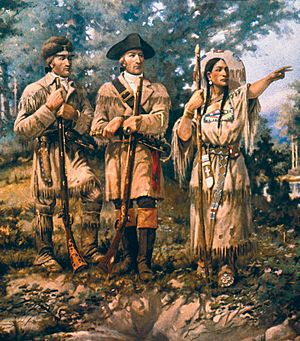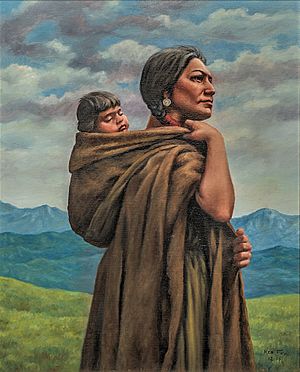Sacagawea facts for kids
Quick facts for kids
Sacagawea
|
|
|---|---|

Sacagawea (right) with Lewis and Clark at the Three Forks, mural at Montana House of Representatives
|
|
| Born | May 1788 Lemhi River Valley, near present-day Salmon, Idaho, US
|
| Died | December 20, 1812 (aged 24) or April 9, 1884 (aged 95) |
| Nationality | Lemhi Shoshone |
| Other names | Sakakawea, Sacajawea |
| Known for | Accompanied the Lewis and Clark Expedition |
| Spouse(s) | Toussaint Charbonneau |
| Children | 2, including Jean Baptiste Charbonneau |
Sacagawea (born around 1788 – died around December 20, 1812) was a brave Lemhi Shoshone woman. She joined the famous Lewis and Clark Expedition as an interpreter and guide. With her help, Lewis and Clark explored the Western United States. They traveled thousands of miles from North Dakota to the Pacific Ocean between 1804 and 1806. Sacagawea's knowledge of the land and languages was very important to the success of their journey.
Contents
Sacagawea's Early Life
There isn't much information known for sure about Sacagawea's early years. When she was about 12 years old, she was captured by a group called the Hidatsa. Later, she was taken as a wife by a French-Canadian fur trapper named Toussaint Charbonneau. He lived in a Hidatsa village.
Joining the Lewis and Clark Expedition
Meeting the Explorers
Sacagawea was pregnant with her first child when the Lewis and Clark Expedition arrived. This group of explorers was called the Corps of Discovery. They spent the winter of 1804–1805 near the Hidatsa villages. Captains Meriwether Lewis and William Clark built a place called Fort Mandan.
They looked for trappers who could help them. They needed someone to translate languages or guide them up the Missouri River. They decided to hire Charbonneau. They learned that his wife, Sacagawea, spoke the Shoshone language. This was very important because they knew they would need help from Shoshone tribes. These tribes lived near the start of the Missouri River.
A New Baby on the Journey
Lewis wrote in his journal on November 4, 1804, about hiring Charbonneau. He mentioned that Charbonneau's two wives were Shoshone. A week later, Charbonneau and Sacagawea moved into the expedition's fort. Clark gave Sacagawea the nickname Janey. Sacagawea gave birth to her son, Jean Baptiste Charbonneau, on February 11, 1805.
Saving Important Items
In April, the expedition left Fort Mandan. They traveled up the Missouri River in boats called pirogues. These boats had to be pushed against the river's flow. Sometimes, they even had to be pulled from the riverbanks.
On May 14, 1805, a boat tipped over. Sacagawea quickly saved many important items. These included the journals and records of Lewis and Clark. The leaders of the expedition praised her quick thinking. They even named the Sacagawea River after her on May 20.
Journey Through the Mountains
Reunion with Her Brother
By August 1805, the group found a Shoshone tribe. They wanted to trade for horses to cross the Rocky Mountains. Sacagawea helped them talk to the tribe. She then discovered that the tribe's chief, Cameahwait, was her own brother!
Lewis wrote in his journal about their emotional reunion. Clark also wrote about how happy Sacagawea was to see her people. The Shoshone agreed to trade horses to the group. They also provided guides to lead them over the cold and bare Rocky Mountains.
Hard Times and Help with Food
The trip through the mountains was very difficult. The explorers even had to eat candles to survive. When they reached the warmer areas on the other side, Sacagawea helped again. She found and cooked camas roots. These roots helped the group regain their strength.
Reaching the Pacific Ocean
As the expedition got closer to the Columbia River on the Pacific Coast, Sacagawea showed her generosity. She gave up her beaded belt. This allowed the captains to trade for a fur robe. They wanted to give this robe to President Thomas Jefferson.
On the way back, they came near the Rocky Mountains in July 1806. Sacagawea helped guide them. On July 6, Clark wrote that Sacagawea knew the area well. She told them they would find a gap in the mountains. This gap is now called Gibbons Pass. A week later, on July 13, Sacagawea told Clark to cross into the Yellowstone River basin. This spot is now known as Bozeman Pass. It was later chosen as the best route for a railway to cross the continental divide.
Sacagawea's Important Role
While Sacagawea is often seen as a guide, she probably only gave directions a few times. Her main job was as an interpreter. She helped the group talk with the Shoshone people.
However, her most important role might have been simply being there. Her presence showed that the expedition did not want to fight any Native Americans they met. Clark noted that "a woman with a party of men is a token of peace." This helped other tribes trust the explorers.
Later Life and Passing
After the expedition, Charbonneau and Sacagawea lived among the Hidatsa for three years. Then, William Clark invited them to live in St. Louis, Missouri, in 1809.
Sacagawea had a daughter named Lizette sometime after 1810. Historical records suggest that Sacagawea passed away in 1812 from an unknown sickness. A fur trader named Henry Brackenridge wrote in 1811 that Sacagawea was "sickly and longed to revisit her native country." In 1812, a clerk named John Luttig wrote that "the wife of Charbonneau, a Snake Squaw, died of putrid fever." He added that she was about 25 years old and left a baby girl.
Documents from Clark show that Sacagawea's son, Baptiste, was already in Clark's care. Clark wanted Baptiste to get an education. Later, in 1813, William Clark became the legal guardian of both Tousant Charbonneau (Baptiste) and Lizette Charbonneau. For a court to do this, both parents had to be confirmed as deceased.
Her Name: Sacagawea or Sacajawea?
Sacagawea is the most common way to spell her name. Lewis and Clark's original journals spelled her name 17 times, using eight different spellings, but all with a "g."
The spelling Sacagawea was officially chosen in 1910 for government documents. The United States Mint used this spelling for the Sacagawea dollar coin. The U.S. Board on Geographic Names and the National Park Service also use it. Many historians use this spelling too.
The spelling Sacajawea is thought to come from the Shoshone words Saca-tzaw-meah. This means 'boat puller' or 'boat launcher'. The Lemhi Shoshone people, her own tribe, prefer the spelling Sacajawea. They believe her Hidatsa captors changed her Shoshone name. They think the Hidatsa pronounced it with a hard "g/k" sound instead of the softer "tz/j" sound that was not in their language.
Memorials and Honors

The Sacajawea Interpretive, Cultural, and Educational Center is in Salmon, Idaho. It's located near the rivers and mountains of Sacagawea's homeland. The center has a small museum and gift shop in a 71-acre park.
Sacagawea was a very important part of the Lewis and Clark Expedition. In the early 1900s, the National American Woman Suffrage Association saw her as a symbol of women's strength and independence. They put up many statues and plaques to honor her. They also helped share her story.
Sacagawea has received many honors:
- In 1959, she was added to the Hall of Great Westerners.
- In 1976, she joined the National Cowgirl Museum and Hall of Fame.
- In 2001, President Bill Clinton gave her the title of Honorary Sergeant in the U.S. Army.
- In 2003, she was inducted into the National Women's Hall of Fame.
- The USS Sacagawea is one of several United States ships named in her honor.
Sacagawea on Coins
In 2000, the United States Mint released the Sacagawea dollar coin. It shows Sacagawea and her son, Jean Baptiste Charbonneau. Since there are no real pictures of Sacagawea from her time, the face on the coin was modeled after a modern Shoshone-Bannock woman named Randy'L He-dow Teton.
Places Named After Sacagawea
Many places are named in her honor:
- Lake Sakakawea in North Dakota.
- Sacajawea Memorial Area at Lemhi Pass. This is a National Historic Landmark where visitors can hike the Lewis and Clark National Historic Trail.
- Mount Sacagawea in Fremont County, Wyoming, and the nearby Sacagawea Glacier.
- Sacagawea Heritage Trail, a bike trail in Tri-Cities, Washington.
- Sacajawea Patera, a large crater on the planet Venus.
- Sacajawea Peak in Wallowa County, Oregon and Custer County, Idaho.
- Sacagawea Park in Gallatin County, Montana.
- Sacagawea River in Montana.
- Sacajawea State Park in Pasco, Washington.
Images for kids
-
Sacajawea and Jean-Baptiste (1905), Washington Park (Portland, Oregon), Alice Cooper, sculptor
See also
 In Spanish: Sacajawea para niños
In Spanish: Sacajawea para niños





